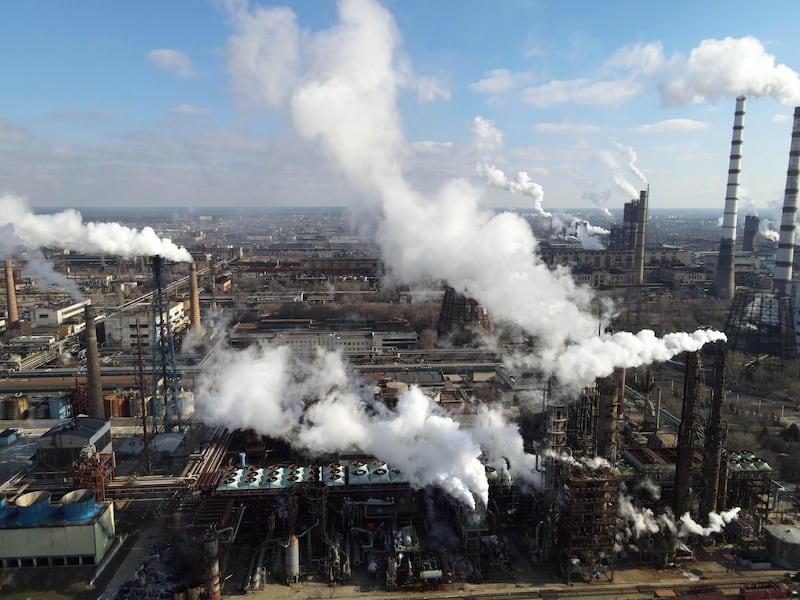Kyiv was hit by four Russian missile strikes early on Sunday morning for the first time in three weeks, during which life had been slowly returning to the Ukrainian capital in the relative calm.
Columns of smoke rose over the central Shevchenkivskyi district, home to a cluster of universities, restaurants and art galleries at 4.22am (6.22am local time). Kyiv’s mayor, Vitali Klitschko, said two residential buildings had been hit in what he called an attempt to “intimidate Ukrainians” before a Nato summit in Madrid beginning on Tuesday.
Around 9am (11am local time), there were at least several unconfirmed reports of two more explosions in Kyiv.
Two people, one a woman from Russia, were taken to hospital and a seven-year-old girl was rescued from rubble, Mr Klitschko said. “She is alive,” he said on Telegram, adding that rescue workers were trying to “save her mother”. He said more residents could be trapped under rubble.
RM Block
“We heard four explosions, they were very loud,” Marina (33) a resident of an apartment building close to the missile strike. “An entire building was shaking. Luckily, our apartment is fine. Originally we are from Chernihiv, we’ve lived through all this and now again ... I don’t know if I want to move out, I need to calm down and then decide.”
The area was previously hit almost two months ago on April 28th in a menacing display of defiance while the UN secretary general was visiting the city and a few hours after Joe Biden had announced a doubling of US military and economic aid to Ukraine.
Vira Hyrych, a Ukrainian journalist from Radio Liberty who also worked for Voice of America, was killed in her apartment by the attack.
The Ukrainian MP Oleksiy Goncharenko wrote on Telegram that “according to prelim data 14 missiles were launched against Kyiv region and Kyiv”. The culture minister, Oleksandr Tkachenko, said on Telegram that a kindergarten was hit in the attacks.

Ukrainian military officials said Kh-101 launched cruise missiles were fired from planes over the Caspian Sea. Ukrainian presidential adviser Oleksiy Arestovych said missile strikes could continue for the whole day in Kyiv.
The capital has not come under Russian bombardment since 5 June, when Russian forces hit the city with cruise missiles fired from the Caspian Sea, striking a rail repair facility.
Meanwhile in eastern Ukraine, Russian forces were trying to cut off Lysychansk, having reduced its twin city Severodonetsk to rubble.
Lysychansk is set to become the next main focus of fighting, as Moscow has launched large artillery bombardments and air strikes on areas far from the heart of the eastern battles.
Russia’s Interfax news agency said Russian troops had entered Lysychansk, the last city held by Kyiv in Luhansk province, on Saturday after Ukrainian forces were ordered to withdraw from Severodonetsk.
If Lysychansk falls, the entire region of Luhansk, which along with Donetsk makes up the eastern Donbas region, could fall under Russian control, marking another strategic breakthrough for the Russian president, Vladimir Putin, since the beginning of the invasion.
“The people’s militia of the Luhansk people’s republic and the Russian army have entered the city of Lysychansk,” Andrei Marochko, a representative for pro-Russia separatists, said on Telegram. “Street fighting is currently taking place,” he said.
The claim could not be independently verified and there was no immediate comment from the Ukrainian side.
Serhiy Haidai, the governor of Luhansk province, said on Facebook that Russian and separatist fighters were trying to blockade Lysychansk from the south and that due to the bombardments the city ‘’is almost unrecognisable”.
[ G7 summit kicks off under shadow of Ukraine war, stagflation riskOpens in new window ]
Mr Haidai said the Azot chemical plant in Severodonetsk and the villages of Synetsky and Pavlograd, and others, were shelled, but made no mention of casualties.
In a separate development on Saturday, 20 rockets “fired from the territory of Belarus and from the air” targeted the village of Desna in the northern Chernihiv region, Ukraine’s northern military command said.
It said that infrastructures were hit, but no casualties had been reported.
Although it is officially not involved in the conflict, Belarus has provided logistic support to Moscow since the beginning of the invasion.
“Today’s strike is directly linked to Kremlin efforts to pull Belarus as a cobelligerent into the war in Ukraine,” the Ukrainian intelligence service said.
The attack came before a planned meeting between Mr Putin and his Belarusian counterpart and close ally, Alexander Lukashenko, in St Petersburg on Saturday.
During the meeting, Mr Putin said he would deliver missiles capable of carrying nuclear warheads to Belarus in the coming months.
“In the coming months, we will transfer to Belarus Iskander-M tactical missile systems, which can use ballistic or cruise missiles, in their conventional and nuclear versions,” Mr Putin said in a broadcast on Russian television.
The development came on the eve of a meeting of G7 leaders in the Bavarian Alps on Sunday, to be hosted by the German chancellor, Olaf Scholz, which is set to be dominated by Ukraine and its far-reaching consequences, from energy shortages to a food crisis. — Guardian
(c) Copyright Thomson Reuters 2022















